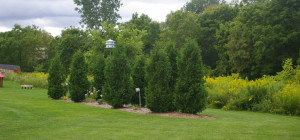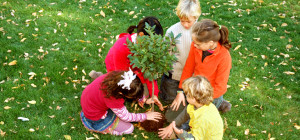 Whether it’s for increased privacy, improved curb appeal or just for fun, planting a new tree in your yard can be a wonderful project. However, there are many trees out there to choose from. It can be difficult to choose between hundreds of different kinds of trees for your yard, but you can narrow your choice down by keeping some key factors in mind.
Whether it’s for increased privacy, improved curb appeal or just for fun, planting a new tree in your yard can be a wonderful project. However, there are many trees out there to choose from. It can be difficult to choose between hundreds of different kinds of trees for your yard, but you can narrow your choice down by keeping some key factors in mind.
What to Avoid
A way to narrow down your choices is to first learn what trees should be avoided for most yards. Various trees have specific negative aspects, but the main trees to avoid are trees that tend to be weak or brittle, especially if you plan on planting close to the house or near power lines, have short life spans or tend to produce a lot of pollen.
Purpose
While some people plant trees for fun, the tree can have a purpose either way. For example, if you’d prefer having more privacy, shade and shield from the wind all year, an evergreen tree would be a good choice. If you’re looking for shade in the summer, sunlight in the fall and appealing leaf blossoms, a deciduous tree would be better.
[youtube https://www.youtube.com/watch?v=j4yvqn29zxY]
Size
Trees come in many shapes and sizes, and it’s important to know which one would look and work best in your yard before planting.
Skinny trees are great for areas with little room, and their branches typically don’t interfere with power lines or cause disturbances or hazards in traffic. They’re also usually much easier to cut down if needed. However, they provide little shade for wide areas, and they may have weaker trunks than wider trees. Some popular choices for skinny trees are the tulip magnolia, cherry and hawthorn.
Wide trees usually look more appealing than skinny trees, and they provide maximum amounts of shade. However, they require a lot of room to grow, take quite a bit of time to grow to maturity, and they may be difficult to remove in the future. Popular wide trees are maple, oak and hickory.
Tall trees, which are typically taller than 45 feet, are also great for large areas by providing the maximum amount of shade. They can also easily work well in small areas if they’re skinny if you want to shade a small private area. Popular tall trees are beech, birch and elm.
Short trees, which are typically under 25 feet tall, are great for small areas or merely decorative purposes. Short trees are also beneficial in areas with high amounts of wind as they pose the least amount of threat to nearby houses and power lines. Popular short trees are crabapple, flowering dogwood and the saucer magnolia.
Medium trees fall between 25 and 45 feet, and they’re a gentle middle ground for those who may want more shade than a short tree can provide while not wanting the hazards of a tall tree. Popular medium trees are snowbell, redbud and golden catalpa.
Additional Features
If you’re looking for something slightly more specific, you’ll need to solidify your additional preferences in features. For example, if you’d like a tree that has flower blossoms, you may enjoy the sassafras, sweetbay magnolia, fringe or chaste trees.
Some people enjoy trees that turn specific colors in autumn. If you’d like a yellow look, the sugar maple or aspen tree could provide it for you. For a redder color, the red maple or sourwood may provide it to you. Baldcypress and sassafras can turn into red-orange colors, and the black tulepo and sweetgum trees can turn purple. Keep in mind that trees can turn many different colors depending on various factors, so you may not end up with the autumn color that you want.
If you’d like a tree that makes fruits, ensure that it will be planted in an area with good drainage to prevent early death of the tree. Popular fruit trees that can be planted across the country are cherry, plum and apricot. Depending on your location, apple, pear and peach trees may be suitable for your yard.
Scottsdale Tree Trimmers is a Scottsdale, AZ-based tree trimming and removal division of American Tree Masters.







